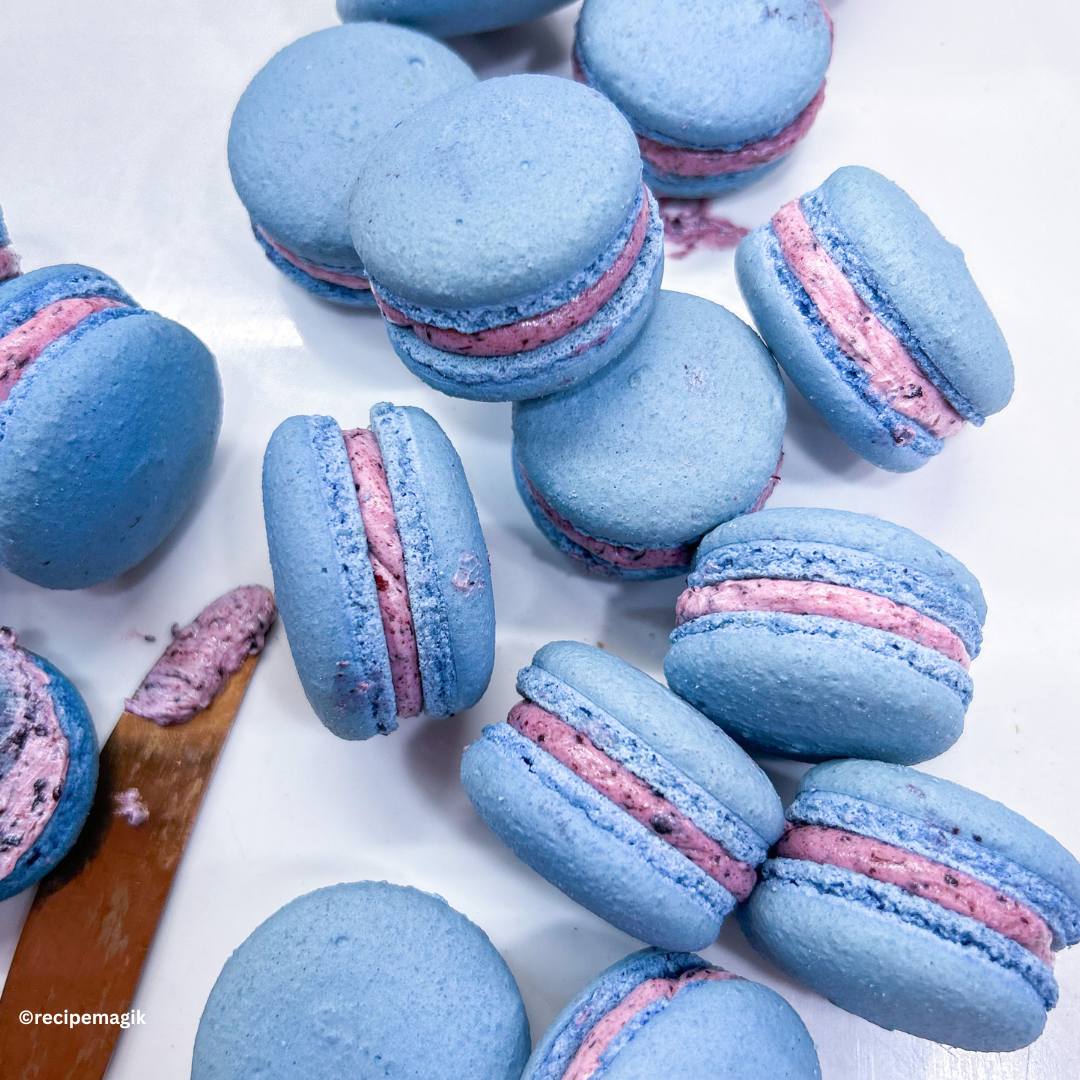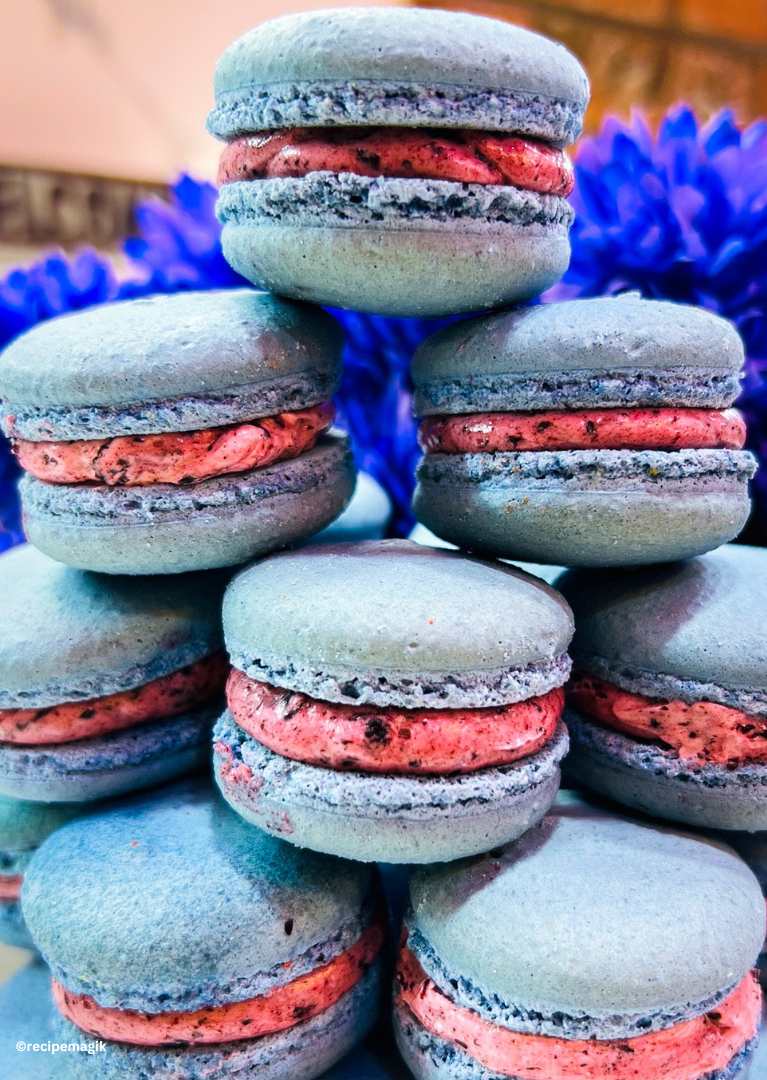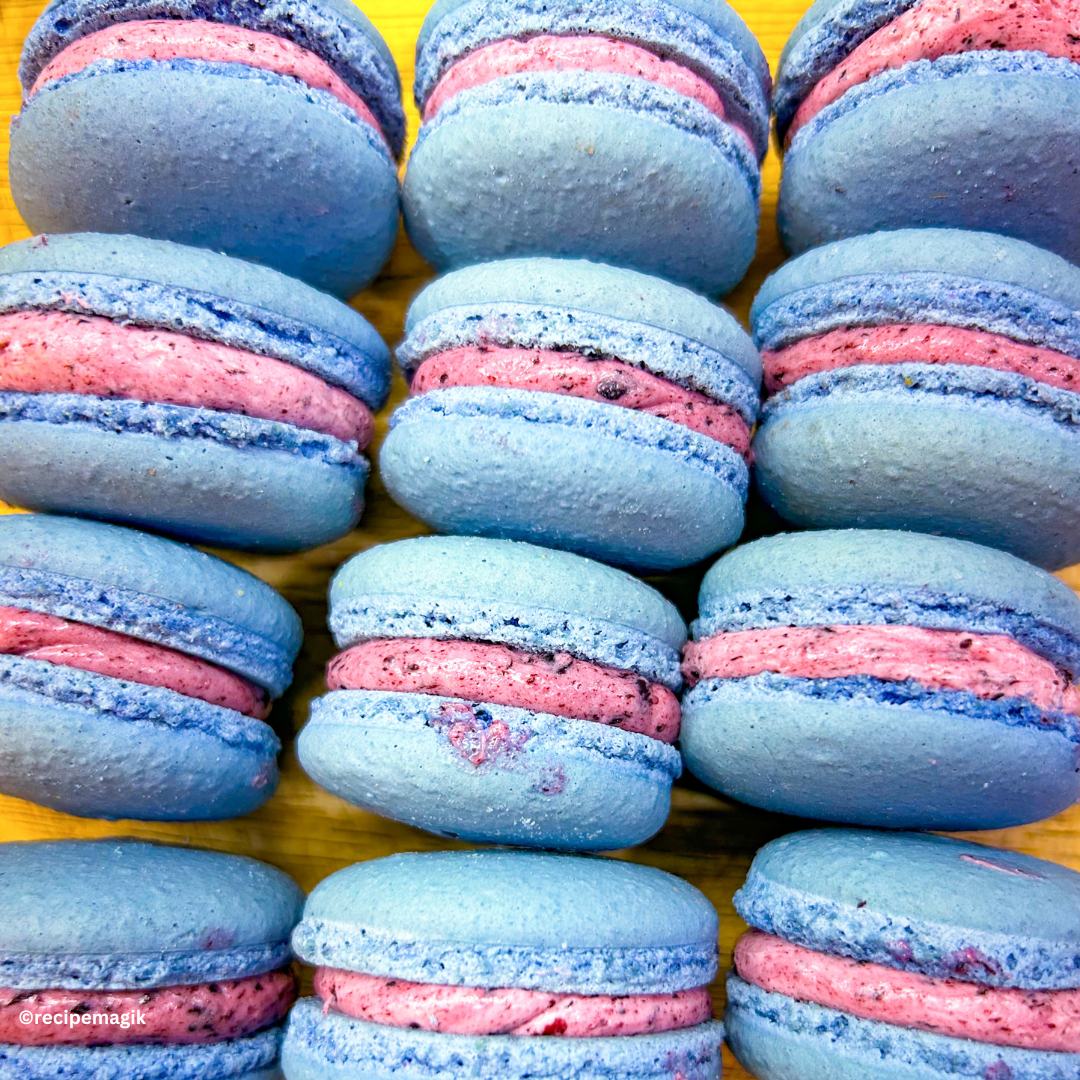Are you a beginner looking for a step-by-step guide to a classic french macaron? Well, here it is. I vividly remember my first attempts at making homemade French macarons in 2017.
Were they good? Absolutely no. But did that stop me? Absolutely No.

So what happens when you keep trying - keeping in mind that you're a beginner and no good - you eventually become good at it? And, if you keep at it until you reach your definition of "good French macarons" you reach excellence!
I can tell it to you with utter confidence that my basic step by step guide to a homemade french macaron recipe will be your stepping stone for success at baking the best french macaron.
Difference between Macaroon and Macaron
Although both are cookies baked from egg whites, Macaroons are not the same as macarons. When we say "Macaroons," we mean - these coconut macaroons. So to formally define - Macaroons mean Coconut Macaroons, with an extra "o". Whereas - Macarons mean delicate egg white cookies with a cream or fruit filling.
Are Macarons French?
Where are Macarons from? Are macarons from France? Are macarons french or Italian?
Well, well, well. There's a lot of confusion here. Some say it's French, some say it's Italian? Which is it? France or Italy?
People say it's French sisters Marguerite and Marie-Elisabeth who created the first Macarons back during the French revolution in 18th century.
While some controversies say it belongs to Italy.
Honestly, let's not get into that debate. Let's focus on the gorgeous beauty of baking that created something called - "Macarons".

Ingredients needed to make French Macaroons
- Egg Whites - The first step of making a macaron is beating/whisking egg whites. That's essentially - Meringue. Therefore, I suggest that you avoid using cartons of egg whites and try using fresh egg whites separated from egg yolk. Make sure that egg yolks don't make it to your meringue. A meringue with stiff peaks - something that holds the shape even when you turn the bowl upside down - needs no egg yolks. Like we saw in a Traditional Chocolate Mousse And, that's step 1 of getting a perfect French Macaron.
- Cream of Tartar - Cream of Tartar is like an added layer of protection when making a meringue. The acidity in cream of tartar helps make stiff peaks in the meringue.
- White Caster Sugar - Not your regular caster sugar, but simply - granulated sugar pulsed several times in the food processor until it resembles a finer texture.
- Almond Flour - Not the same thing as Almond meal. Check out this article where I have explained the difference between Almond Meal vs. Almond flour But make sure it's of the best quality.
Do you have to age Egg whites?
You'll find so many websites or people telling you that aging egg whites is totally something that you can skip. But not me!
I always age my egg whites. That's one of the secrets to a stiff meringue and, eventually, a stable macaron.
How to age egg whites?
- Use two clean glass bowls wiped dry using a paper towel.
- Brush vinegar or lemon juice to ensure there are no remnants of fat in the bowl.
- Crack eggs in a separate bowl (third bowl) using a spoon and separate egg whites using your hands or an egg white separator (if you have one)
- Separate the egg yolk and whites.
- Cover the bowl with egg whites with a plastic wrap and poke some holes to make sure the moisture evaporates.
- Place it in the refrigerator for 3-4 days or at least 24 hours (1 day) before using.
- Allow the egg whites to come to room temperature before making a meringue.
I forgot to age my Egg whites. What do I do?
Happens to me all the time. Not a big deal. Use meringue powder (powdered egg whites). 1/2 teaspoon of meringue powder to a batch of fresh egg whites adds extra protein and dries off the fresh egg white. But using Meringue powder is not ideally recommended.

How to Make French Macarons?
Well, if you're a beginner then you'll be baking your first batch of Homemade french macarons. And, I am super-excited for you. Here is a step by step guide for the recipe of French Macarons.
STEP 1: Measure and Sift the dry ingredients
Even if the package says "super-fine almond flour," you'll still have to pulse and sift it again until it becomes "pulverized."
- The first step of making a classic French macaron is to measure granulated sugar and almond flour.
- Pulse it in a food processor at least 10 times until it becomes super fine.
- Sift it gently without forcing the big particles (if any).
PRO TIP - Take a little extra while measuring ingredients because when you sift, you will throw off some of it.
STEP 2: Beat Egg whites (making Meringue)
Meringue forms the base of the macarons. Overmixing or undermixing the meringue is a common problem here.
- Beat 50-gram egg whites from eggs with a 1/8 teaspoon of salt and 1/8 teaspoon of cream of tartar. At first, the mixture will look foamy, and you'll see bubbles forming. Keep beating until you see soft, droopy peaks.
- Now add 1/3 cup of sugar and beat for 5 seconds.
- Add another 1/3 cup of sugar and beat for another 5 seconds.
- Lastly, add the remaining sugar and beat just until you see stiff peaks.
- This is a perfect meringue. You could turn the bowl upside down, and the meringue won't fall.
- Now add your gel food coloring and extract (vanilla/almond/coconut) and beat lightly.
Overmixed meringue is something when you have a large stiff peak. You should be aiming for small stiff peaks. Hollow macarons are a result of overmixed meringues.
PRO TIP - Wipe the bowl with vinegar and lemon juice to remove the fat before making the meringue.
STEP 3: Macaronage - Deflating the macaron batter
One of the most important step to ensure your macaroon has a "dainty feet and smooth top"
- Fold in 1/3 rd of the almond mixture. The best way to do this is to use a spatula and go to the bottom, scrape it down, and fold it in. Do it gently.
- Then, add the remaining almond mixture and fold it until you get a wet sand-like "ribbony" / "lava" like consistency. In this step, you are deflating the air from the mixture.
- The ideal way to know that you are there is when you can make a figure "8" like a ribbon without the mixture breaking apart.
- That's when you should stop.
STEP 4: Pipe the Macaron Batter and refrigerate for 30 minutes
- Transfer the Macaron batter into a piping bag with a round tip.
- Pipe it onto a silicone mat or parchment paper placed on a large baking tray.
- Tap/Bang the baking tray on the counter top a couple of times to deflate the air bubbles (if any)
- Refrigerate the baking tray with unbaked macarons until the top forms a smooth skin/shell.
- This helps the top from cracking when they are being baked.
- Meanwhile Preheat oven to 320 degrees F.
STEP 5: Bake
- Place Macarons in a preheated oven.
- Bake for 12 to 14 minutes (only one tray at a time)
- Take them out and check for doneness. The feet shouldn't stick to the parchment paper and the top shouldn't be wobbly.
- The macaron should come out from the silicone mat/parchment paper with no effort.
- Allow the macarons to cool down completely on a wire rack.
STEP 6: Pipe the filling
- Fill the macarons with your favorite filling. You can make Lemon Buttercream Frosting or Maple Buttercream Frosting or Chocolate buttercream frosting or Vanilla Buttercream frosting.
- Leave them in the fridge overnight in an airtight container for maturation.
- Bring them back to room temperature at least 30 minutes before serving.
Foolproof Tips and Tricks for a Classic Macaron
- Allow your eggs to come to room temperature for at least 30-minutes before you start the recipe.
- Pulse your dry ingredients for a smoother top.
- Make sure you sift your dry ingredients to get that lump-free smooth top.
- While beating egg whites, add sugar gradually. Don't add all the sugar at once because that'll deflate the air.
- Keep beating your egg whites until you see stiff peaks.
- Add Vanilla extract or Almond extract only after you've whisked your egg whites to stiff peaks.
- Make sure you use gel food coloring instead of liquid food coloring, as the latter has a tendency of adding more moisture to the meringue.
- While folding dry ingredients, add 1/3 rd of the batter and keep beating vigorously until you get that "wet sand" consistency.
- See if you can make the figure "8" without breaking the batter. - That's a trick I learned from Tasty.
- Pipe the macarons onto a silicone mat or a parchment paper. In my personal experience, both work fine.
- There is no such rule as per the size of the macaron. If you want, you can buy a template to pipe on.
- Pat the baking tray on the kitchen counter a few times so that the air bubbles come down.
- Allow the macarons to set in the fridge for 30 minutes before placing them in the oven. This extra time in the fridge smoothens the top and helps them rise better.
- Bake until the macarons comes off easily from the parchment paper.
- If the macarons are stuck onto the parchment paper then your macarons need a few more minutes in the oven.
- Cool them down on a wire rack before piping the filling.
More Desserts you should try:
Easy french Macaron recipe step by step for beginners
Print Pin RateINGREDIENTS
- 65 grams almond flour
- 65 grams granulated sugar
- 45 grams castor sugar
- 50 grams egg whites *see notes #1
- ⅛ teaspoon salt
- ⅛ teaspoon cream of tartar
- ¼ teaspoon extract vanilla or coconut or almond or peppermint
- 3-4 drops gel food coloring avoid liquid food color
INSTRUCTIONS
Prep Dry Ingredients
- Measure almond flour and granulated sugar using a kitchen scale. Pulse them in a food processor at least 10 times until they get pulverized.
- Sift the almond mixture gently, not forcing big particles into the bowl. Discard the remnants in the sifter.
Meringue
- Wipe a clean large bowl with vinegar or lemon juice to remove any traces of fat from it. Add room-temperature egg whites and whisk on low using a stand mixer fitted with a paddle attachment or a hand mixer until you see it becoming frothy.
- Now add in cream of tartar and salt. Whisk on low until the bubbles begin to tighten; and you can see the beater leaving tracks in the egg white mixture.
- Add ⅓rd of castor sugar and beat on medium speed for 5 seconds. Add another ⅓rd portion of sugar and beat for another 5 seconds. Then, add the remaining castor sugar and beat until you see small soft peaks and the sugar is fully incorporated.
- Now you can add any extract (vanilla or peppermint or coconut, or almond) and gel food coloring. Beat until you see Small Stiff Peaks.
- Check the doneness of the meringue. You should be able to see Stiff Pointed Peaks when you pull out the whisk.
Macaronage
- Macaronage means deflating the air bubbles. Add ⅓rd portion of the dry ingredients (almond mixture) into the meringue. Use a spatula to go down to the bottom, scrape the bowl, and then fold it in. Do this gently yet vigorously enough to deflate the air bubbles. Repeat with another 1/3rd portion of the almond mixture until combined.Lastly, dump in the remaining dry mixture and lightly deflate the air bubbles until it forms a "wet sand" / "honey" or "lava" like consistency.It should be ribbony, and you should be able to make Figure 8 with the mixture without the mixture breaking apart.When you can make Figure 8, stop mixing.
Pipe the macarons
- Transfer the macaron batter into a piping bag with a round tip.
- Arrange baking trays with silicone mat or parchment paper.
- Pipe the macarons no more than 1.5 to 2 inches in diameter keeping a gap of at least 2 inches between them.
- Bang/Tap the baking tray on the kitchen counter top to pop out any air bubbles.
- Pop out any remaining air bubbles using a toothpick.
- Transfer the baking sheets with unbaked macarons into the fridge. Refrigerate for 30 minutes or more until the top layer is smooth and gets a "skin/shell". This extra time in the refrigerator prevents your macarons from cracking on the top and also helps them develop those dainty feets when they rise up in the oven.
- Meanwhile Preheat oven to 320 degrees F.
- Bake one tray at a time. Bake the macarons in the middle tray for 12 to 14 minutes.
- Take them out and check for doneness. The feet of the macarons shouldn't push back and they should come out swiftly. The top shouldn't be brown (overbaked) nor unsteady and wobbly (underbaked).
- Transfer to a wire rack and allow the macarons to cool down completely.
- Make your favorite frosting - cream cheese frosting, salted caramel frosting, mascarpone frosting, maple buttercream frosting, chocolate cream cheese frosting, lemon buttercream frosting or vanilla buttercream frosting, or any other filling that you like.
- Once the macarons have cooled down, pipe the frosting with any tip you want.
- Refrigerate the macarons in an airtight container overnight. After 24 hours of maturation, keep them at room temperature for 30 minutes before serving.
Notes
- I would recommend aging the egg whites for a firm macaron. See the blog post on how to age egg whites and what to do if you forgot to age them.



Ask Me Anything